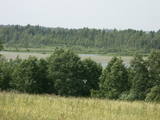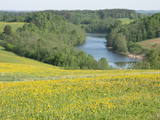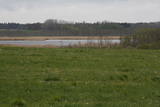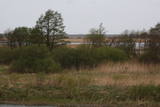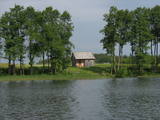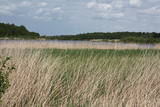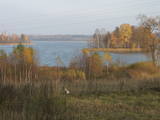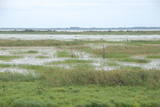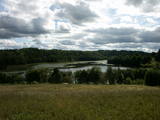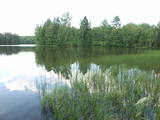| Nr | Nosaukums | Apraksts |
|---|---|---|
|
Dabas liegumā ietilpst divi aizauguši ezeri ar grūti pieejamiem krastiem - Lielais un Mazais Asūnes ezers, kas atrodas dienvidos no Asūnes ciema. Abus ezerus var vērot, atrodoties ārpus lieguma teritorijas - no blakus esošo pauguru augstākajām daļām, kas atrodas austrumos no abiem ezeriem. Ja līdzi būs paņemts tālskatis, iespējams, izdosies iztālēm novērot šeit esošās aizsargājamās putnu sugas, piemēram, melno zīriņu. |
||
|
Dabas parks veidots Latgales augstienes Dagdas pauguraines izteiktākās daļas un Baltijas dziļākā ezera (63,1 m) – Drīdza, tā salu (kopā – 9 salas), Ota ezera un to apkārtnes aizsardzībai. Skaistākie skati paveras no senā latgaļu pilskalna – Sauleskalna un Drīdza ezera austrumu daļā. Ezera krastos pieejamas naktsmītnes. |
||
|
Dabas lieguma teritorija ieskauj nelielo Tāšu ezeru un tam pieguļošos ar krūmiem apaugušos purvainos krastus šaurā joslā. Teritorija veidota šeit esošo reto ligzdojošo un migrējošo putnu aizsardzībai. Dabas lieguma teritoriju var lieliski pārskatīt no nelielajiem grants ceļiem, kas to apjož no visām pusēm un atrodas ārpus aizsargājamās teritorijas. Dienvidos no Tāšu ezera atrodas Tāšu muižas komplekss. |
||
|
Tosmares ezers – bijusī Litorīnas jūras lagūna mūsdienās ir sekla (0,5 – 1,2 m) un stipri aizaugusi ūdenstilpe, ko migrāciju un ligzdošanas laikā iecienījušas daudzas putnu sugas, kas kopā ar aizsargājamiem augiem ir nozīmīgākā teritorijas vērtība. Ezera rietumu un dienviddaļā atrodas nozīmīgs vēstures piemineklis - Liepājas fortifikācijas sistēmas nocietinājuma daļas un Cietokšņa kanāls. Līdztekus tam virzās 11. Novembra bulvāris, no kura vietām pārskatāma daļa no lieguma teritorijas. Labs skats paveras arī no fortu paliekām ezera dienviddaļā. Rietumos no Tosmares dabas lieguma atrodas Karosta – viens no interesantākajiem Latvijas militārā mantojuma pieminekļiem ar neparastu tūrisma piedāvājumu. |
||
|
Ļoti ainavisks ezers, uz kuru paveras lieliskas ainas no Vidzemes augstienes pauguriem. Te jāatceras latviešu teika par Ineša un Alauksta strīdu, kā rezultātā Inesis dabūja pliķus – salas, kurām (sešām) tāpat kā Sproģu pussalai ir dabas lieguma statuss. |
||
|
Līčiem, pussalām un salām bagāts ezers ar izrobotu krasta līniju, kas savienots ar Zvejnieku un tālāk - citiem Latgales augstienes ezeriem. Ozolu un platlapju meži, kas aug uz ezera salām un pussalās ir ne tikai aizsargājami, bet arī Latvijas mērogā nozīmīgi biotopi. Tiesa, to vērtību apzināsies tikai vides speciālisti. No Jašas ezera var uzsākt laivu braucienu pa vienu no Latgales ezeru "kēdēm". Ezera austrumu krastā atrodas Geļenovas parks.
|
||
|
Lieguma galvenā „vērtība” ir seklais un aizaugošais ezers, kas ir ne tikai svarīga daudzu putnu sugu ligzdošanas, bet kopā ar palieņu pļavām – arī augu sugu dzīves vieta. No ezera ziemeļdaļas iztek Svētupe. Ezera apkārte nav piemērota tūrisma pasākumiem. Alternatīva - uz dienviediem esošā Limbažu Lielezera krastā izveidota dabas taka.
|
||
|
Valguma ezers – līdz 3 km garais un
27 m dziļais ezers izvietojies ledāja
veidotā gultnē
|
||
|
Dabas liegums veidots ezera, tā salu, ainavas, augu, putnu un sikspārņu aizsardzībai. Liegumu var apskatīt "no malas" - no ceļa, kas iet gar tā ziemeļu un ziemeļaustrumu robežu.
|
||
|
Ārkārtīgi ainaviska teritorija Augšzemes augstienes centrālajā daļā ar vairākiem ezeriem - Medumu, Lielo un Mazo Ilgas, Šķirsteņu un dažām mazākām ūdenstilpēm. Medumu ezera salām ir dabas lieguma statuss. Teritoriju šķērso vairāki grantēti ceļi, no kuriem dažviet paveras brīnišķīgas, bet nelabiekārtotas skatu vietas. Teritorijā atrodas Medumu katoļu baznīca. Piemērota teritorija dažādu aktīvā tūrisma veidu attīstībai. Dabas parks ietilpst Augšzemes aizsargājamo ainavu apvidū. |
||
|
Lubāna ezers, Lubāna mitraine. Lubāns – platības ziņā lielākais
ezers (80,7 km2) Latvijā, vislielākais iedambētais ezers Eiropā, un ap
to esošais Lubāna mitrājs bioloģiskās daudzveidības ziņā ir unikāla
vieta ne tikai Latvijā, bet arī starptautiskā mērogā – dabas liegums,
iekļauts Eiropas Savienības aizsargājamo teritoriju tīklā NATURA 2000
un atbilstoši Ramsāres konvencijas kritērijiem – starptautiskas nozīmes
mitrājs. Lubāna mitrājs, ko vietējie iedzīvotāji jau izsenis dēvē par
klāniem, ir zemie un augstie purvi, slapjās pļavas, mitrie meži.
Rudeņos un pavasaros ūdenskrātuvēs apmetas tūkstošiem migrējošu
ūdensputnu, kurus ērti novērot no putnu novērošanas torņiem vai ūdenstūrisma attīstības centra terases.
|
||
|
Salīdzinoši liels (3 km garš, 1,3 km plats) un sekls (līdz 1,1 m) piejūras ezers, caur kuru tek Vecslocene. Ezera dienviddaļā šaura caurteka to savieno ar Aklo ezeru – seklu un nelielu ezeriņu ar dolomīta gultni dažās vietās. Labākais skats uz Slokas ezeru paveras no putnu vērošanas torņa tā ziemeļrietumu krastā, kas ir vienīgais uz peldošiem pontoniem celtais Latvijā putnu tornis. Pie tā sākas 3 km garā Slokas ezera pastaigu taka, kuras izcilākā vērtība ir aplūstošie Vēršupītes lejteces dumbrāji. Slokas ezera krastā pie auto stāvlaukuma uzstādīts informatīvs stends, bet aiz tā – apskatāms sēravots. |
||
|
Ilziņš jeb Vestienas dzirnavezers pazīstams ar nostāstiem par tajā "periodiski uzpeldošām kūdras salām". Saskaņā ar vietējo iedzīvotāju sniegtajām ziņām, minētā parādība gan sen jau vairs nav novērota. Tajā pat laikā ezers un tā apkārtne ir nozīmīga daudzu aizsargājamu biotopu un sugu dzīves vieta. Ezers ietilpst Vestienas aizsargājamo ainavu apvidū. Ezeru var redzēt, braucot pa Ērgļu - Gaiziņkalna ceļu. Var pakāpties arī blakus esošajā paugurā (ziemeļos no minētā ceļa un ezera), no kura paveras plašāka skatu perspektīva.
|
||
|
Viens no dažiem Latvijas dzidrūdens ezeriem. Apskatāms no Lubānas - Ļaudonas ceļa malas pie Visagala. Lai saudzētu šo ezeru, tajā esošos aizsargājamos biotopus un sugas, ūdenstilpē nevajadzētu peldēties lielām cilvēku masām un pieļaut cilvēka darbības produktu nonākšanu ezerā.
|
||
|
Rāznas ezers (57,8 km2), saukts par Latgales jūru, pēc ūdens
ietilpības lielākais Latvijā, atrodas Latgales augstienes Rāznavas paugurainē.
Tā gleznainajā apkārtnē paceļas Latgales augstākās virsotnes un
latgaļu pilskalni. Ezera krastos atrodas iecienītas atpūtas vietas. Lai
pasargātu un saglabātu unikālo dabas kompleksu, izveidots Rāznas
Nacionālais parks un teritorija iekļauta Eiropas Savienības aizsargājamo
teritoriju tīklā Natura 2000. Ezerā ir 10 salas, divi līči. Ezera ūdens līmenis
ir 163,8 m virs jūras līmeņa.
|
||
|
Saukts arī par Jēša vai Ieša ezeru. Salām bagātākais Latvijas ezers ar aptuveni 35 salām. Visvairāk salu ir ezera ziemeļaustrumu daļā, bet lielākā sala ir Lielā Lāču sala (45 ha), uz kuras pat savulaik atradusies viensēta. |
||
|
Stipri aizaudzis un sekls
piejūras ezers, kura ūdens līmeni
vairākkārt regulēja 20. gs. (mērķis iegūt
lauksaimniecībā izmantojamas zemes).
Ezerā ir 14 salas, no kurām 9 ir dabiskas,
bet pārējās – mākslīgi veidotas ligzdojošo
ūdensputnu piesaistīšanai. Kaņieris ir viens
no putniem bagātākajiem ezeriem Latvijā.
Jau 1964. g. te izveidoja Kaņiera ezera
ornitoloģisko liegumu, 1989. g. ezeru
iekļāva Eiropas nozīmīgo putnu vietu, bet
1995. g. Ramsāres konvencijas vietu
sarakstā. Ezera dienvidaustrumu krastā
atrodas Laivu bāze (Kaņierī drīkst braukt
tikai ar tajā īrētu laivu). 2009. g. Riekstu
pussalā uzcelts putnu vērošanas tornis.
|
||
|
Dziļezers ar Riebezeru, kā arī pārējie – Mazezers, Auziņu ezers, Skujas ezers un Bruņķītis atrodas subglaciālā (Ledāja veidotā) iegultnē, kuras krastos un nogāzēs aug dažādu tipu, t.sk. platlapju (piemēram, ošu) meži - aizsargājami biotopi. Pie Priedīšu mājām izveidotā un labiekārtotā dabas taka iepazīstina ar Dziļezeru un tā apkārtni. Taka ejama vietējā gida pavadībā. Dziļezera ziemeļaustrumu krastā atrodas laivu bāze.
|
||
|
Dabas parks veidots Burzavas pauguraines, Adamovas ezera (eitrofs ezers) un tā krastos sastopamo biotopu un sugu, t.sk. sikspārņu aizsardzībai. Visskaistākie skati uz dabas parku paveras no pauguriem, kas atrodas ezera ziemeļu krastā. Ezera krastos atpūtu piedāvā vairākas naktsmītnes, bet parka tuvākajā apkārtnē tūristus uzņem populāri Latgales novada podnieki. |
||
|
Līčainā un pussalām bagātā Ciriša ezera (atrodas Ciriša dabas parkā) klājs rotājas ar vairākām salām, no kuras lielākā – Upursala savā koku lapotnē ir paslēpusi Upurkalnu - senu latgaļu pilskalnu. Tā pakājē konstatētas senas apmetnes liecības un atrastas trauku lauskas, akmens kalts un citi priekšmeti. Salas austrumdaļas piekrastē izveidota laivu piestātne, bet apkārt salai - labiekārtota dabas taka. Pilskalnā uzvedīs koka kāpnes. Laivu var sarunāt viesu namā „Aglonas Cekuli”. |
||
